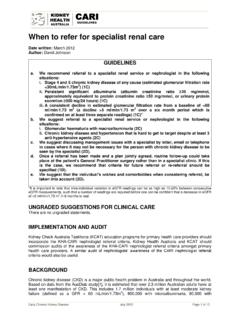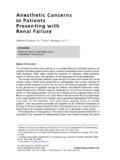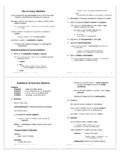Transcription of IRIS Staging of CKD (modified 2016)
1 1 Staging is undertaken following diagnosis of chronic kidney disease (CKD) in order to facilitate appropriate treatment and monitoring of the patient. Staging is based initially on fasting blood creatinine concentration, assessed on at least two occasions in the stable patient. The patient is then substaged based on proteinuria and blood pressure. Separate but related algorithms for Staging and substaging CKD in cats and dogs are available on pages 6 - 9 of this document. Using these criteria, some empirical recommendations can be made about the type of treatment it would be logical to use for these cases. In addition, predictions based on clinical experience might be made about the likely response to Staging of CKD ( modified 2016 )1. Staging of CKD based on blood creatinine concentration mol/lStageBlood CreatinineCommentsAt Risk1234<125< suggests the animal is at increased risk of developing CKD in the future because of a number of factors (such as, exposure to nephrotoxic drugs, breed, high prevalence of infectious disease in the area, or old age).
2 Nonazotemic. Some other renal abnormality present (such as, inadequate urinary concentrating ability without identifiable nonrenal cause, abnormal renal palpation or renal imaging findings, proteinuria of renal origin, abnormal renal biopsy results, increasing blood creatinine concentrations in samples collected serially).Mild renal azotemia (lower end of the range lies within reference ranges for many laboratories, but the insensitivity of creatinine concentration as a screening test means that animals with creatinine values close to the upper reference limit often have excretory failure). Clinical signs usually mild or <140< <125< <140< renal azotemia. Many extrarenal clinical signs may be present.>440> >440> risk of systemic clinical signs and uraemic crisesNote these blood creatinine concentrations apply to average size dogs those of extreme size may vary 2016 International Renal Interest Society ( iris ) Ltd.
3 iris Ltd. is an independent non-profit organization limited by guarantee in the UK (Registered Number 10213173). This website is supported by an annual grant provided by Elanco Animal Health, a division of Eli Lilly and website made possible by2 Symmetric dimethylarginine (SDMA) and iris CKD guidelinesIRIS CKD Staging is based currently on fasting blood creatinine concentrations, but there are indications that SDMA concentrations in blood plasma or serum may be a more sensitive biomarker of renal function. Accordingly, if blood SDMA concentrations are known, some modification to the guidelines might be considered, as follows: A persistent increase in SDMA above 14 g/dl suggests reduced renal function and may be a reason to consider a dog or cat with creatinine values < or < mg/dl, respectively, as iris CKD Stage 1. In iris CKD Stage 2 patients with low body condition scores, SDMA 25 g/dl may indicate the degree of renal dysfunction has been underestimated.
4 Consider treatment recommendations listed under iris CKD Stage 3 for this patient. In iris CKD Stage 3 patients with low body condition scores, SDMA 45 g/dl may indicate the degree of renal dysfunction has been underestimated. Consider treatment recommendations listed under iris CKD Stage 4 for this patient. These comments are preliminary and based on early data from the use of SDMA in veterinary patients. We expect them to be updated as the veterinary profession gains further experience using SDMA alongside creatinine, the long-established marker in diagnosis and monitoring of canine and feline assays are offered by a number of laboratories throughout the world. The methodology used has not yet been standardized and the recommendations made above are based on the proprietary methodology offered by Idexx Laboratories Substaging by Proteinuria The goal is to identify renal proteinuria having ruled out post-renal and pre-renal causes.
5 Standard urine dipsticks can give rise to false positives therefore practitioners should consider using a more specific screening test such as the sulphosalicylic acid turbidometric test. The urine protein to creatinine ratio (UP/C) should be measured in all cases, provided there is no evidence of urinary tract inflammation or hemorrhage and the routine measurement of plasma proteins has ruled out dysproteinemias. Ideally Staging should be done on the basis of at least two urine samples collected over a periodof at least 2 Staging of CKD ( modified 2016 )UP/C ValueSubstage< to proteinuricProteinuric> < to > 2016 International Renal Interest Society ( iris ) Ltd. iris Ltd. is an independent non-profit organization limited by guarantee in the UK (Registered Number 10213173). This website is supported by an annual grant provided by Elanco Animal Health, a division of Eli Lilly and website made possible by3 iris Staging of CKD ( modified 2016 )Patients that are persistently borderline proteinuric should be re-evaluated within 2 months and re-classified as in the non-proteinuric or borderline proteinuric range may be categorized as microalbuminuric.
6 The significance of microalbuminuria in predicting future renal health is not understood at present. iris recommendation is to continue to monitor this level of may decline as renal dysfunction worsens and so may be less frequent in animals in Stages 3 and to any treatment given to reduce glomerular hypertension, filtration pressure, and proteinuria, should be monitored at intervals using Substaging by Arterial Blood PressurePatients should be acclimatized to the measurement conditions and multiple measurements taken. The final classification should rely upon multiple systolic blood pressure determinations, preferably done during repeated patient visits to the clinic on separate days, but acceptable if during the same visit with at least 2 hours separating determinations. Patients are substaged by systolic blood pressure according to the degree of risk of target organ damage, and whether there is evidence of target organ damage or BloodPressure mm HgBlood PressureSubstage<150 Normotensive150-159 Borderline hypertensiveHypertensive160-179 Risk of FutureTarget Organ Damage 180 Severely HypertensiveMinimalLowModerateHighHoweve r, some breeds, particularly sight hounds, tend to have higher blood pressure than other breeds.
7 It is preferable to use breed-specific reference ranges if available. The classification of risk of future target organ damage in high-pressure breeds might be adjusted as follows:Minimal risk systolic pressure <10 mm Hg above the breed-specific reference rangeLow risk systolic pressure 10-20 mm Hg above the breed-specific reference rangeModerate risk systolic pressure 20-40 mm Hg above the breed-specific reference rangeHigh risk systolic pressure >40 mm Hg above the breed-specific reference range. 2016 International Renal Interest Society ( iris ) Ltd. iris Ltd. is an independent non-profit organization limited by guarantee in the UK (Registered Number 10213173). This website is supported by an annual grant provided by Elanco Animal Health, a division of Eli Lilly and website made possible byAs with proteinuria, in the absence of evidence of existing target organ damage, demonstration of persistence of blood pressure readings within a particular category is important.
8 Persistence of increase here should be judged on multiple measurements made over the following timescales in these blood pressure substages: Hypertensive systolic blood pressure 160 to 179 mm Hg measured over 1 to 2 months Severely hypertensive systolic blood pressure 180 mm Hg measured over 1 to 2 Revision of Staging and substaging after treatment The stage and substages assigned to the patient should be revised appropriately as changes occur. For example, a substantial increase in blood creatinine concentration might warrant reassignment to a higher stage to reflect the new situation. Similarly, if antihypertensive (or antiproteinuric) treatment has been instituted, the patient s classification on re-evaluation should be adjusted if necessary to reflect the new blood pressure (or UP/C) rather than the original status, with the addition of an indication that the current classification is affected by treatment.
9 The following two examples illustrate the process of revision, where treating is used as an indicator of ongoing treatment. Example 1 Cat before treatment Creatinine 200 mol/l ( mg/dl)UP/C blood pressure 200 mm HgClassification iris CKD Stage 2, borderline proteinuric, severely hypertensive. Same cat after antihypertensive treatment Creatinine 300 mol/l ( mg/dl)UP/C blood pressure 155 mm HgNew classification iris CKD Stage 3, borderline proteinuric, borderline hypertensive (treating). Example 2 Dog before treatment Creatinine 160 mol/l ( mg/dl)UP/C blood pressure 155 mm HgClassification iris CKD Stage 2, proteinuric, borderline hypertensive. Same dog after antiproteinuric treatment Creatinine 170 mol/l ( mg/dl)UP/C blood pressure 155 mm HgNew classification iris CKD Stage 2, borderline proteinuric(treating), borderline Staging of CKD ( modified 2016 )8 2016 International Renal Interest Society ( iris ) Ltd.
10 iris Ltd. is an independent non-profit organization limited by guarantee in the UK (Registered Number 10213173). This website is supported by an annual grant provided by Elanco Animal Health, a division of Eli Lilly and website made possible byIRIS Staging of CKD ( modified 2016 )Algorithm for Staging of Chronic Kidney Disease in DogsHistory and/or physical examinationsuggest chronic kidney disease (CKD)Measure blood creatinineCreatinine<125 mol/l< mg/dlCreatinine 125 180 mg/dlCreatinine>180 mol/l> mg/dlFirm evidence of CKD presentFirm evidence of CKD absentSubstage by UP/C & BPStage 1 Radiographs and ultrasound, UP/C, BP and urine cultureInstitute managementplan for Stage 1 patientsRe-evaluate in 2-3 months, then every 3 months if creatinine rising; every 3-6 months if creatinine stableMeasure urine specific gravityMeasure urine specific gravity< and ultrasound, UP/C, BP and urine cultureNormal: re-evaluate within 2 monthsAbnormal: Stage 2 Substage by UP/C& BPIf underlying systemic abnormalities, correct and re-evaluatewithin 6 monthsInstitute treatmentCorrect underlying abnormalities andre-evaluate immediatelyInstitute treatmentStage 3 or 4 Substage by UP/C & BPPre- or post-renal azotaemiaRenal azotaemia5 2016 International Renal Interest Society ( iris ) Ltd.











